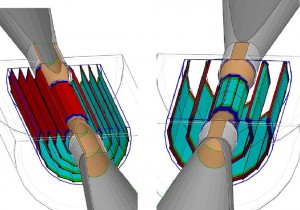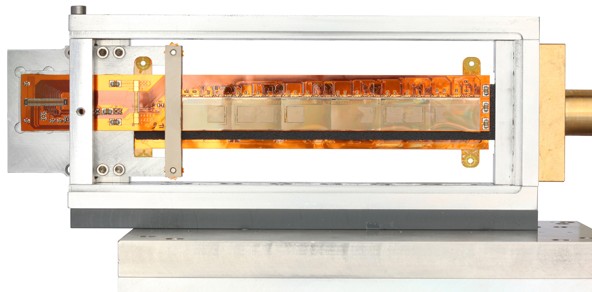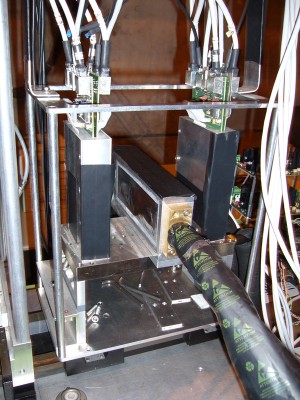
Possible geometries for the ILC International Large Detector. Shown on the left is a design based on five single-sided layers; on the right, a design based on three double-sided layers. Image: ILD
A group of European physicists, the PLUME collaboration, aims to prototype an ultra-light device intended to equip one of the thinnest and lightest elements at the inner heart of the ILC detectors: the vertex detector. At CERN one month ago, a full-scale prototype equipped with CMOS pixel sensors was successfully tested in beam.
At the ILC, physicists will take advantage of the well defined interaction parameters and of moderately demanding running conditions (compared with those of the Large Hadron Collider at CERN, for example) to scrutinise phenomena involving very short-lived particles such as tau leptons or charm particles. This implies challenging specifications for the ILC detectors in terms of precision, especially for the sub-detector closest to the interaction region, the vertex detector.
Compared to an LHC detector, an ILC vertex detector will need to be significantly lighter and more precise. On the other hand, its sensitivity to radiation damage will not be a major concern for most of the detection technologies available today, but the hit occupancy and the power consumption remain driving parameters. ILC physicists thus have to find a new, linear-collider-specific trade-off between these competing parameters and look for novel sensor technologies suited to this peculiar combination of specifications.
CMOS pixel sensors are one of the pixel technologies (besides CCDs, DEPFETs, and others) potentially complying with the requested performances. They are under development in several countries around the world, including France, the UK and the USA.
For more than ten years now, the Institut plurisdisciplinaire Hubert Curien (IPHC), a CNRS / University of Strasbourg lab in France, is developing CMOS pixel sensors for various applications. For many years, most of the ILC-related developments have been pursued in collaboration with CEA/Irfu in Saclay, France. The sensors have the peculiarity of being monolithic, which means that they integrate in the same chip the charge sensing part and the signal processing micro-circuits. Their 10- to 20- micrometre-thin sensing layer and their highly integrated read-out circuitry allow them to be made very thin. One of the most recent versions, called MIMOSA-26, thinned to 50 micrometres, is already equipping beam telescopes on test beam lines at both DESY in Germany and CERN. Adapted versions are also getting used in subatomic physics experiments.
The vertex detector will of course be made of a large number of sensors. And though MIMOSA-26 has already shown very promising performances as a single sensor, one may ask what happens when the full vertex detector is paved with them. Will these properties stay the same after integration?
“This is by far not obvious,” says Jérôme Baudot, University of Strasbourg researcher belonging to the PICSEL team at IPHC. “While integrating a sensor, you introduce a mechanical structure and electrical cables, which all add extra material seen by traversing particles. Moreover, the air flow needed to evacuate the dissipated heat tends to induce mechanical vibrations. All these effects can alter the genuine spatial resolution. Despite being well known, they have not yet been demonstrated to be under control when the targeted single point resolution is better than three micrometres.”
The appropriately named PLUME (Pixelated Ladder with Ultra-low Material Embedding) project (the name “plume” means “feather” in French) is developing ultra-light “ladder” prototypes that are supposed to match the specifications of an ILC vertex detector. The double-sided ladder concept consists of two layers of sensors, each connected on a micro-cable, separated by a light support structure made of foam.
So, what does this ladder look like? Six sensors are butted on each side, adding up to a total sensitive area of 12 x 1 cm2. It contains eight million pixels and is read entirely in about 100 microseconds. The present prototype weighs 10 grammes. In terms of physics, these 10 grammes stand for 0.6 percent of radiation length. The final goal of PLUME is to reduce the amount of material crossed by particles down to about 0.3 percent in 2012. For this to happen, the PLUME team expects to manage substantially reducing the foam density and the micro-cable material.
The PLUME ladder prototype was tested at the CERN-SPS from 30 October to 6 November, and its performances were assessed. “We are very enthusiastic with the preliminary results, since we measured that the spatial resolution on the track crossing point is the same for the ladder as for a single sensor in stand-alone operation.” said Baudot. “It is actually better – below three micrometres – when combining the information from both sides of the ladder. Also, having a double-sided ladder allows us to estimate the track direction with a resolution of about 1.5 milliradians from our preliminary analysis. These two features illustrate some of the benefits expected from the double-sided ladder concept.”
The precise determination of the detection efficiency of this particle tracker, among the thinnest and quickest ever built, requires more detailed analysis. “Nevertheless, the challenge is already partially won with a preliminary value in excess of 99.5 percent,” he said.
The PLUME project gathers physicists from DESY, the Universities of Oxford and Bristol in the UK and IPHC in France. With these promising results, the collaboration demonstrated that the approach followed to realise ladders adapted to an ILC vertex detector is on a good track for achieving the challenging performance level required by the ILC physics programme.



Recent Comments